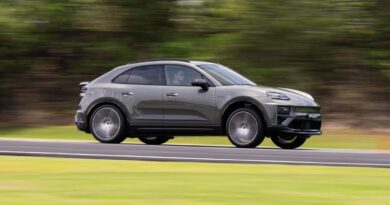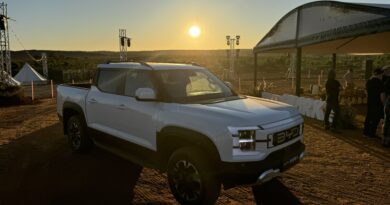Has the Nissan Leaf got its mojo back? EV pioneer returns as an SUV-coupe to challenge the Tesla Model Y and BYD Atto 3
The 2026 Nissan Leaf has been officially unwrapped, with the EV pioneer transitioning from a small hatch to a mid-size SUV in a bid to make more of a sales impact than ever before.
The new Nissan Leaf goes on sale in Q2 of 2026 with the Japanese brand’s latest Tesla Model Y alternative tipped to land a little later next year in Australia.
Among its headline improvements, the sleek SUV-coupe arrives with up to 604km range.
READ MORE: Turning over a new Leaf: Fresh 2026 Nissan LEAF details emerge ahead of pioneering switch from hatch to Kia EV3 or Volvo EX30 rival
READ MORE: Nissan Leaf SUV revealed as Tesla Model Y rival! Rush of new product to lead Nissan’s survival fight
READ MORE: V2G tech takes next step in Australia with Nissan Leaf making money from the grid
With a design tailored to SUV-obsessed Australians’ tastes, the Leaf employs the sportier SUV-coupe profile for a reason.
Combined with smooth frontal styling, active grille shutter technology, pop-out door handles and a flat underbody, the Nissan EV claims a very respectable drag coefficient of just 0.25.
Contributing to that, both the new 18-inch and 19-inch alloy wheels have been optimised for low drag and the Nissan’s rear door handles are tucked within the C-pillar.
At the rear there’s a neat integrated spoiler and dark tinted taillights that pleasingly hint at the firm’s sportiest Nissan Z.
Despite looking larger than the current hatch, the new SUV is 10mm shorter than the current Leaf.
Based on the Renault-Nissan-Mitsubishi CMF-EV platform – the same underpinnings adopted by the bigger Nissan Ariya and Renault Megane E-Tech – the Leaf measures in at 4405mm long, 1810mm wide and 1550mm tall.
A relatively long 2690mm wheelbase enhances interior space.
An electric tailgate opens to reveal a boot with luggage space up to 437 litres.
In Europe there’s the choice of two front-wheel-drive powertrains. There is no word yet of more powerful dual-motor or Nismo versions.
The base Leaf Standard comes with a 130kW/345Nm e-motor that is powered by a 52-kilowatt-hour battery for a WLTP verified range of up to 436km.

Off the line the cheapest LEAF will sprint from 0-100km/h in 8.6 seconds before topping out at 160km/h.
A longer-range Leaf Extended gets a more powerful 160kW/355Nm e-motor with a larger 75kWh battery. Nissan says it’s it can cover the headline range figure of 604km.
With more power and fractionally more torque, it launches from 0-100km/h in 7.6 seconds, but tops out at an identical 160km/h.
While the 52kWh battery can be topped up at up to 105kW, the larger 75kWh accepts a charge of up to 150kW. Both cars take less than 30 minutes for a 20 to 80 per cent top-up.
Since Nissan says the Leaf is a credible alternative to those switching from a regular combustion car, on European highway speeds at a steady 130km/h the small-battery Leaf is said to be able to cover up to 224km on a charge.
Meanwhile, the Leaf Extended can cruise for 330km before it needs topping up – around when many pull over for a rest, even in a long-range diesel.
Improving real-world charging times is a navigation-linked pre-conditioning function that cools or heats the battery to the optimum temperature for a top-up when the Leaf arrives at a charging station.

From launch a vehicle-to-load (V2L) functionality will allow the new Leaf to charge small and medium devices, with the Nissan providing up to 3.6kW of power.
Some regions, like the US, will benefit from a vehicle-to-grid capability that will allow users to reduce their running costs by selling back power to the electricity grid during peak times.
Onboard, the new Leaf features a clean minimal cabin with the car-maker’s latest in-car tech that comprises of either dual 12.3-inch or larger twin 14.3-inch displays.
To reduce driver distraction on the move there’s a multi-function two-spoke steering wheel and touch-sensitive shortcuts on the dash. The gear lever has been banished for a row of buttons.
Fresh tech includes an optional panoramic roof that incorporates the latest e-Dimming tech. This combines electrochromic tech and an infrared reflective coating and at the touch of the button the large piece of glass can switch from clear to opaque.
Range-topping models also come with a powerful Bose sound system that features headrest speakers.
Advanced new driver-assist tech includes an Intelligent Around View Monitor that incorporates an invisible bonnet view and a front-wide monitor. From launch some markets will get an advanced adaptive cruise control that will work in the city.

Full pricing and local specifications will be announced closer to the new Leaf’s arrival.
So far there is little indication given by Nissan Europe how it will position the new Nissan EV against not only the larger dominant Tesla Model Y, but also the influx of cheaper Chinese EVs.




